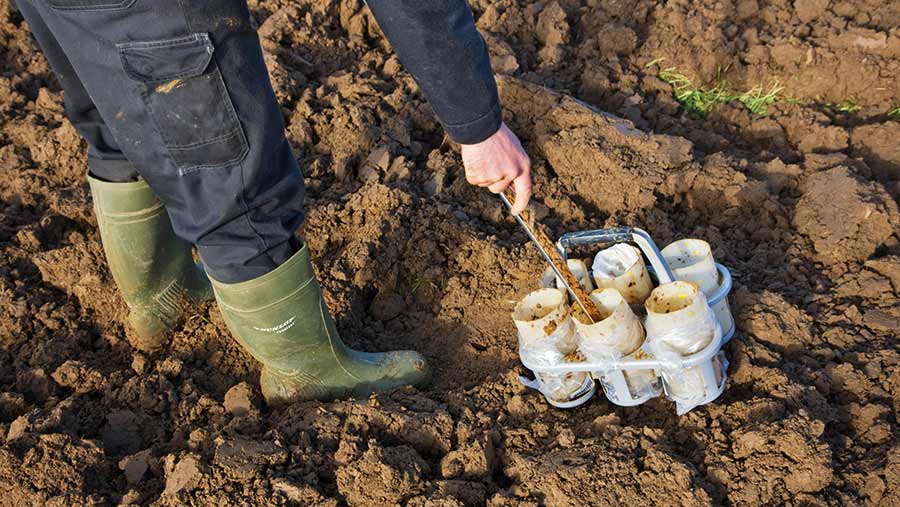Why soil management is so vital to reducing emissions
 © Arterra Picture Library/Alamy Stock Photo
© Arterra Picture Library/Alamy Stock Photo The decarbonisation of food production will be one of the defining undertakings of our industry this century, as farmers play their part to reach the UK’s target of net-zero emissions by 2050.
Indeed, the NFU’s aspiration is for agriculture to reach that target a decade earlier.
See also: What to consider when increasing soil carbon stocks
Certainly, no other industry is in as advantageous a position, with farmers managing more than 70% of our land – and all the possibilities for carbon sequestration that brings – alongside the rapid development of strategies to reduce direct emissions via managerial, technological and biological processes.
Careful management of our soils is key to these future aspirations, and the growing use of “regenerative” farming techniques will help to drive a burgeoning interest in building soil health and carbon.
At the GWCT Allerton Project, a 320ha research and demonstration farm in Loddington, Leicestershire, we are lucky to have soil scientist Jenny Bussell as a full-time member of the team.
Over recent years, Dr Bussell has been undertaking a comprehensive range of soil research at our heavy-land site, much of it using our Gasmet portable greenhouse gas analyser, which allows us to measure a range of soil emissions in real time.
Compaction research
One trial conducted as part of the EU-wide SoilCare project was to assess the effects of compaction on soil productivity and emissions.
It’s well known that moving from inversion tillage to a reduced- or zero-tillage system can have beneficial outcomes for soil organic matter retention and an associated drop in soil carbon dioxide emissions.
However, what is not as widely appreciated is the effect compaction – more likely in a reduced-tillage system – can have on associated emissions of nitrous oxide, a greenhouse gas 300 times more warming than carbon dioxide, with a persistency of more than a century.
Although levels of nitrous oxide – both in the atmosphere and as a percentage of national emissions – are low, the potency of the gas gives cause for concern, and agriculture is responsible for some 75% of UK emissions.
Much of this derives from soil management, primarily during the microbial process of denitrification, in which inorganic nitrate (NO₃) is converted to nitrous oxide. This occurs in wet, anaerobic soil conditions and particularly in heavier soils.
The SoilCare trial saw us intentionally compact an arable field by driving over it repeatedly (a heartbreaking process!) before running a series of split plots, including ploughed, direct-drilled and direct-drilled following a pass with a low-disturbance subsoiler.
In wet winter soils we recorded nitrous oxide emissions 10-15 times higher in the compacted direct-drilled plot versus the ploughed and subsoiled plots, respectively.
In dry summer conditions, with the soil no longer providing the (un)favourable anaerobic conditions, comparative nitrous oxide emissions were similar between the treatments.
But we also found that carbon dioxide losses from the two “disturbed” plots (subsoiled and ploughed) were significantly higher in winter than in the direct-drilled plot, as might be expected as microbes found more available oxygen to help metabolise the soil organic matter.
When we added the two sets of emissions together and adjusted for the global warming potential of nitrous oxide v carbon dioxide, we found the overall emissions between all treatments were similar – in other words, the total soil GHG emissions from compacted direct-drilling were the same as those from the cultivated plots.
Thus, on soils liable to anaerobic winter conditions, simply moving to a direct-drilled system may not offer benefits from a carbon accounting and climate point of view – although the fuel savings (about 50% between direct-drilled and ploughed) would factor in favour of the compacted direct-drilled area if taken into account.
In this trial we were dealing with intentionally compacted ground. Across the wider Allerton Project, we can demonstrate that well-managed soils do not have the same nitrous oxide issues in a direct-drilled system.
But mechanical intervention may sometimes be necessary to avoid such an outcome, and indeed can be an important element of long-term soil health, as well as offering an important agronomic reset in situations with high weed burdens.
Also being investigated by Dr Bussell is gas flux data indicating that our long-term direct-drilled soils have higher average carbon dioxide emissions than those which have been continually ploughed.
This is linked to the greater diversity and mass of respiring biology in the soil (indicating a healthier soil), but needs to be squared with the concurrent increase in soil organic matter in those direct-drilled soils, and is part of ongoing research.
As with all aspects of the journey to net zero and more sustainable farming, there are few “silver bullets” or simple answers to the question of how we reduce emissions from our soils while building soil health and sequestering carbon.
But we hope to be providing part of the answer here at the Allerton Project in the coming years.

